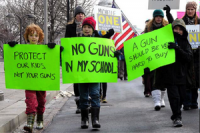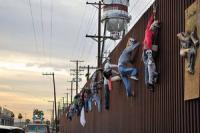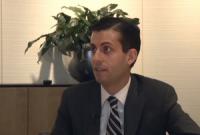-
Understanding mass shootings in America
At least 17 people were killed Wednesday afternoon in a shooting at Marjory Stoneman Douglas High School in Parkland, Florida. The gunman, a former student at the school, was armed with a rifle and multiple magazines, officials said. The shooting came 23 days after a 15-year-old student shot 16 of his classmates, two of them fatally, at Marshall County High School, in Benton, Kentucky. The FBI does not count “mass shootings,” but rather “mass murder,” which the bureau defines as an event in which four or more people are killed — excluding the perpetrator, and not including domestic violence incidents — at one time. Despite the attention they garner, mass shootings account for just 2 percent of gun deaths in the United States.
-
-
Why security measures won’t stop school shootings

When deadly school shootings like the one that took place on Valentine’s Day in Broward County, Florida occur, often they are followed by calls for more stringent security measures. While some of these measures seem sensible, overall there is little empirical evidence that such security measures decrease the likelihood of school shootings. Surveillance cameras were powerless to stop the carnage in Columbine and school lock-down policies did not save the children at Sandy Hook. We believe what is missing from the discussion is the idea of an educational response. Current policy responses do not address the fundamental question of why so many mass shootings take place in schools. To answer this question, we need to get to the heart of how students experience school and the meaning that schools have in American life. It is time to think about school shootings not as a problem of security, but also as a problem of education.
-
-
Competing rights: Florida shooting highlights tension between two rights
Many Americans accept the current gun trade-off: Much easier access to guns relative to other advanced societies – with a far larger number of gun fatalities relative to these advanced societies. Unless this general acceptance of the current trade-off changes – and this would amount to a cultural change — we are not going to see any meaningful legislative changes to the issue of access to guns. But the question that events such as the Florida school shooting raises should still be considered: It has to do with the clash between two constitutionally protected rights: The right to bear arms and the right for life and liberty. Americans have the right to bear arms, but they also have a fundamental right to life, that is, the right to live, which also means the right not to be killed by another human being. To paraphrase Abraham Lincoln’s words (in his “All the laws but one” response to Chief Justice Taney): Should we be so adamant and so narrowly restrictive in our refusal to read the Second Amendment more broadly, even if the result of this absolutism is that other rights – fundamental rights, like the right to life —are being eroded?
-
-
The ATF received 36,000 comments on bump stocks. They’re overwhelmingly anti-regulation.
In the week following the Las Vegas massacre on 1 October, polls showed that nearly 75 percent of registered voters in gun-owning households supported a ban on bump stocks. Yet despite the public sentiment, an analysis of comments submitted in response to a government proposal to regulate bump stocks shows that 85 percent of commenters opposed the measure.
-
-
2017 anti-Semitic incidents in the U.K. on the rise
The Community Security Trust’s (CST) 2017 Anti-Semitic Incidents Report, published Thursday, shows that CST recorded 1,382 anti-Semitic incidents in the United Kingdom in 2017, the highest total CST has ever recorded for a calendar year. This is a 3 percent increase from the 1,346 incidents recorded during 2016, which was itself a record annual total. The previous record high was in 2014, when CST recorded 1,182 anti-Semitic incidents. A copy of the report can be downloaded here. In addition to the 1,382 anti-Semitic incidents, a further 872 reports of potential incidents were received by CST in 2017 but were not deemed to be anti-Semitic and are not included in this total. Many of these 872 potential incidents involved suspicious activity or possible hostile reconnaissance at Jewish locations; criminal activity affecting Jewish people and buildings; and anti-Israel activity that did not include anti-Semitic language, motivation or targeting.
-
-
Some real “bombshell news” in the Mueller investigation
Former Trump team legal spokesperson Mark Corallo, in the summer of 2016, had concerns that White House communications director Hope Hicks may be considering obstructing justice after a comment she made in a conference call about emails between Donald Trump Jr. and Russians with ties to the Kremlin. “Mark Corallo is a pro’s pro who went to work for the Trump legal team completely on board and who wanted to help the president … well, make America great again. When he left after two months with some reports that he was troubled by what he was seeing … that was a deeply ominous sign,” Jim Geraghty writes in National Review. “If Corallo ends up offering sort of critical testimony, this is not because he’s a Judas or because he’s part of the establishment or some sort of ‘Deep State’ sellout. It’s because he saw stuff that genuinely struck him as either illegal or unethical or both and he’s not the kind of person who’s willing to lie under oath about it.”
-
-
Dutch intelligence instrumental in launching FBI’s investigation into U.S. election meddling
In 2014, Dutch government hackers from AIVD, the Dutch intelligence agency, managed to infiltrate “the computer network of the infamous Russian hacker group Cozy Bear,” a Dutch newspaper reports. A year later, the Dutch operatives witnessed “Russian hackers launching an attack on the Democratic Party in the United States.” The penetration of the Russian network allowed the Dutch intelligence services to provide the FBI with valuable information. The Steele Dossier was taken so seriously by the FBI not only because Christopher Steele was a credible and reliable Russia expert – but because much of the raw intelligence contained in the dossier dovetailed with information the FBI already had from other sources – one of them being Dutch intelligence.
-
-
Prosecuting background check, straw purchase violations depends on state laws
A new study found that prosecutions in Pennsylvania for violating the state’s straw purchase law increased by nearly 16 times following the 2012 passage of a law requiring a mandatory minimum five-year sentence for individuals convicted of multiple straw purchase violations. So-called straw purchases involve a prohibited person, such as someone with a criminal record, enlisting the aid of another person to buy the firearm on their behalf.
-
-
Texas smugglers say Trump's border wall wouldn't stop immigrants, drugs from pouring across the border

If the Trump administration follows through on the president’s promises to build a border wall, would it actually stop undocumented immigrants and illegal drugs? Two former smugglers explain how they’d work around it.
-
-
Dog shoots man: Dog shoots his hunter-owner dead
A Russian hunter was fatally shot by his dog. Police investigators who examined the incident said that the man was shot when his dog stepped on the trigger of a loaded rifle. The man, on a hunting trip on Sunday, was letting his dogs out of the trunk of a car when one of the dogs stepped on the trigger of a loaded hunting rifle, killing the man.
-
-
The man who knew too much

In November 2006, on orders of Vladimir Putin, Russian operatives used radioactive material to poison and kill Alexandr Litvinenko, a former KGB colleague who had turned a fierce critic of the Russian leader, and who was living with his family in London. Yesterday, the British government froze the assets of the two Russian agents – one of them has been awarded a medal by Putin, and is now a leading member of United Russia, Putin’s political party, in the Russian parliament. Ten years later, in November 2016, a leading British nuclear forensic scientist – who was part of the 2006 investigation and who was instrumental in tying the nuclear material used in the killing to the two Russian agents — was found dead in his home, after returning from an academic research trip to Russia. It was the 14th Russia-related killing on British soil since 2006. The number of individuals with inside knowledge of the Putin regime and its practices — and who have met an untimely end in mysterious circumstances — is growing, and British lawmakers urge the government to show more resolve in investigating this string of killings.
-
-
Predicting criminal risk: Court software may be no more accurate than web survey takers
A widely-used computer software tool may be no more accurate or fair at predicting repeat criminal behavior than people with no criminal justice experience, according to a new study. The analysis showed that non-experts who responded to an online survey performed equally as well as the Correctional Offender Management Profiling for Alternative Sanctions (COMPAS) software system used by courts to help determine the risk of recidivism.
-
-
U.S. gun deaths in 2017: 15,549 (excluding suicides) – 3 percent increase over 2016
At least 15,549 people were killed by guns in the United States in 2017, excluding most suicides, according to data collected by Gun Violence Archive (GVA), a nonprofit organization that tracks media and law enforcement reports of shootings. The number, which marks a 3 percent increase over the previous year. There were 31,157 firearm injuries in 2017, a rise of nearly 2 percent over the previous year. The number of people killed in mass shootings declined from 456 in 2016 to 433 in 2017.
-
-
New government terrorism report provides little useful information

The Departments of Homeland Security and Justice (DHS/DOJ) on Tuesday released a report on the threat of international terrorism. The new DHS/DOJ report produces little new information on immigration and terrorism and portrays some misleading and meaningless statistics as important findings. For example, since the beginning of 2002 through 2017, native-born Americans were responsible for 78 percent of all murders in terrorist attacks committed on U.S. soil while foreign-born terrorists only committed 22 percent. Including the actual number of deaths caused by terrorists flips the DHS/DOJ statistics on its head. Also: During 2002-2017, the chance of being murdered in a terrorist attack committed by a native-born American on U.S. soil was about one in 40.6 million per year. During the same period, the chance of being murdered by a foreign-born terrorist was about 145 million per year. The annual chance of being murdered in a non-terrorist homicide was about one in 19,325 per year, or about 1,641 times as great as being killed in any terrorist attack since 9/11.
-
-
Racial, political identities influence people’s view of fatal police encounters
People’s racial and political identities strongly shaped how they viewed the causes of several recent widely publicized police encounters that resulted in the deaths of African-American men, according to a new study. African-Americans, liberals and Democrats generally attribute the cause of fatal encounters between officers and black citizens to broader problems in policing. Others generally would view the encounters as phenomena limited to the actions of a few actors.
-
- All
- Regional
- Water
- Biometrics
- Borders/Immig
- Business
- Cybersecurity
- Detection
- Disasters
- Government
- Infrastructure
- International
- Public health
- Public Safety
- Communication interoperabillity
- Emergency services
- Emergency medical services
- Fire
- First response
- IEDs
- Law Enforcement
- Law Enforcement Technology
- Military technology
- Nonlethal weapons
- Nuclear weapons
- Personal protection equipment
- Police
- Notification /alert systems
- Situational awareness
- Weapons systems
- Sci-Tech
- Sector Reports
- Surveillance
- Transportation
Advertising & Marketing: advertise@newswirepubs.com
Editorial: editor@newswirepubs.com
General: info@newswirepubs.com
2010-2011 © News Wire Publications, LLC News Wire Publications, LLC
220 Old Country Road | Suite 200 | Mineola | New York | 11501
Permissions and Policies
Editorial: editor@newswirepubs.com
General: info@newswirepubs.com
2010-2011 © News Wire Publications, LLC News Wire Publications, LLC
220 Old Country Road | Suite 200 | Mineola | New York | 11501
Permissions and Policies
